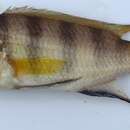ar
الأسماء في صفحات التنقل


Maylandia livingstonii és una espècie de peix de la família dels cíclids i de l'ordre dels perciformes.[6]
Fa 15 cm de llargària màxima.[7][8]
Les femelles són incubadores bucals, la fecundació té lloc a llur boca[9] i custodien els ous a la cavitat bucal durant, si fa no fa, 19 dies.[10]
Es nodreix d'invertebrats i diatomees[11] que troba a la sorra.[12] El seu nivell tròfic és de 3,13.[13]
És un peix d'aigua dolça (pH entre 8 i 9), demersal (entre 2 i 50 m de fondària) i de clima tropical (22°C-26°C;[14] 13°S-15°S), el qual viu a l'Àfrica Oriental: és un endemisme de les àrees sorrenques del llac Malombe[11] i del sud del llac Malawi (Malawi).[15][16][17][18][19][20][21][22][23][24][25][26][27][28][4][8][29]
És un peix territorial, el qual troba refugi a les closques buides del gastròpode Lanistes nyassanus. Quan abandona el seu refugi, esdevé solitari o forma petits grups de menys de 5 individus.[8]
És inofensiu per als humans[8] i forma part del comerç internacional de peixos ornamentals.[11]
Maylandia livingstonii és una espècie de peix de la família dels cíclids i de l'ordre dels perciformes.
Pseudotropheus livingstonii[1] (Syn.: Maylandia livingstonii, Metriaclima livingstonii) ist eine kleine Buntbarschart, die endemisch im ostafrikanischen Malawisee vorkommt. Die Art wurde zu Ehren des schottischen Afrikaforschers David Livingstone benannt, der den See auf der Suche nach den Quellen des Sambesi 1859 erreichte und „Lake Nyasa“ nannte.
Männliche Pseudotropheus livingstonii erreichen eine Maximallänge von 14 cm, Weibchen bleiben etwas kleiner. Sie sind relativ hochrückig und seitlich stark abgeflacht. Die Männlichen Fische sind blau, mit gelb gesäumter Rücken- und Afterflosse, gelber Schwanzflosse und gelber Kehle. An der Afterflosse befinden sich mehrere gelbe Flecken. Eine Zeichnung von schwarzen bis dunkelblauen Streifen verläuft senkrecht über den ganzen Körper. Die Weibchen sind unscheinbar mit gelb-braunen unpaaren Flossen.
Pseudotropheus livingstonii lebt über reinen Sandflächen in Bereichen, wo Schneckengehäuse der Apfelschneckengattung Lanistes zu finden sind. Die Schneckengehäuse nutzen die Fische jedoch nur als Versteck und nicht als Laichplatz, wie die im Tanganjikasee endemischen Schneckenbuntbarsche. Pseudotropheus livingstonii pflegt seine Brut als Maulbrüter. Die Brutdauer beträgt 16 Tage. Beim Verlassen des elterlichen Mauls sind die Jungfische relativ klein. Pseudotropheus livingstonii ernährt sich von wirbellosen Tieren, die im Sand aufgespürt werden, und von Detritus.
Pseudotropheus livingstonii (Syn.: Maylandia livingstonii, Metriaclima livingstonii) ist eine kleine Buntbarschart, die endemisch im ostafrikanischen Malawisee vorkommt. Die Art wurde zu Ehren des schottischen Afrikaforschers David Livingstone benannt, der den See auf der Suche nach den Quellen des Sambesi 1859 erreichte und „Lake Nyasa“ nannte.
Maylandia livingstonii is a species of cichlid native to Lake Malawi and Lake Malombe.[1] This species can reach a length of 15 centimetres (5.9 in) TL. It can also be found in the aquarium trade.[3] The specific name of this fish honours the Scottish explorer and missionary David Livingstone (1813-1873).[4]
Maylandia livingstonii is a species of cichlid native to Lake Malawi and Lake Malombe. This species can reach a length of 15 centimetres (5.9 in) TL. It can also be found in the aquarium trade. The specific name of this fish honours the Scottish explorer and missionary David Livingstone (1813-1873).
Pseudotropheus livingstonii es una especie de peces de la familia Cichlidae en el orden de los Perciformes.
Los machos pueden llegar alcanzar los 15 cm de longitud total.[1][2]
Se encuentra en el África Oriental: es una especie endémica del lago Malawi.
Pseudotropheus livingstonii es una especie de peces de la familia Cichlidae en el orden de los Perciformes.
Maylandia livingstonii Maylandia generoko animalia da. Arrainen barruko Actinopterygii klasean sailkatzen da, Cichlidae familian.
Maylandia livingstonii Maylandia generoko animalia da. Arrainen barruko Actinopterygii klasean sailkatzen da, Cichlidae familian.
Maylandia livingstonii est une espèce de poisson d'eau douce de la famille des cichlidae endémique du lac Malawi et lac Malombe[2] en Afrique. Cette espèce de cichlidae est conchylicole[3] pratiquant le camouflage et la reproduction aux abords des coquilles d'escargots morts.
Au moins deux variétés géographiques sont connues[4] :
Cette espèce mesure adulte une taille maximale avoisinant les 8 centimètres.
Même adulte cette espèce de cichlidae n'est pas toujours aisément différentiable. Souvent le mâle est légèrement plus grand et d'aspect plus affirmé (robuste).
Cette espèce est incubatrice buccale ovophile maternelle, les femelles gardent les œufs, larves et tout jeunes alevins environ 17 jours[3].
L'Union internationale pour la conservation de la nature IUCN place cette espèce en "Préoccupation Mineur" (LC) : "Présent dans les Lacs Malawi et Malombe où il est répandu sans grandes menaces généralisées identifiés"[2]
Il est impératif de maintenir cette espèce et le genre Maylandia seul ou en compagnie d'autres espèces, d'autres genres, mais de provenance similaire (lac Malawi), afin d'éviter toute facilité de croisement.
Maylandia livingstonii est une espèce de poisson d'eau douce de la famille des cichlidae endémique du lac Malawi et lac Malombe en Afrique. Cette espèce de cichlidae est conchylicole pratiquant le camouflage et la reproduction aux abords des coquilles d'escargots morts.
Maylandia livingstonii is een straalvinnige vissensoort uit de familie van de cichliden (Cichlidae).[1] De wetenschappelijke naam van de soort is voor het eerst geldig gepubliceerd in 1899 door Boulenger.
Bronnen, noten en/of referentiesMaylandia livingstonii é uma espécie de peixe da família Cichlidae.
É endémica do Malawi. Os seus habitats naturais são: lagos de água doce.
Maylandia livingstonii é uma espécie de peixe da família Cichlidae.
É endémica do Malawi. Os seus habitats naturais são: lagos de água doce.
Maylandia livingstonii là một loài cá thuộc họ Cichlidae. Nó là loài đặc hữu của Malawi. Môi trường sống tự nhiên của chúng là hồ nước ngọt.
Maylandia livingstonii là một loài cá thuộc họ Cichlidae. Nó là loài đặc hữu của Malawi. Môi trường sống tự nhiên của chúng là hồ nước ngọt.
利文斯通擬麗魚,為輻鰭魚綱鱸形目隆頭魚亞目慈鯛科的其中一種,分布於非洲馬拉威湖東南部流域,體長可達15公分,棲息在沙底質底層水域,雄魚具有領域性,以腹足類的殼為巢穴,屬雜食性,可作為觀賞魚。